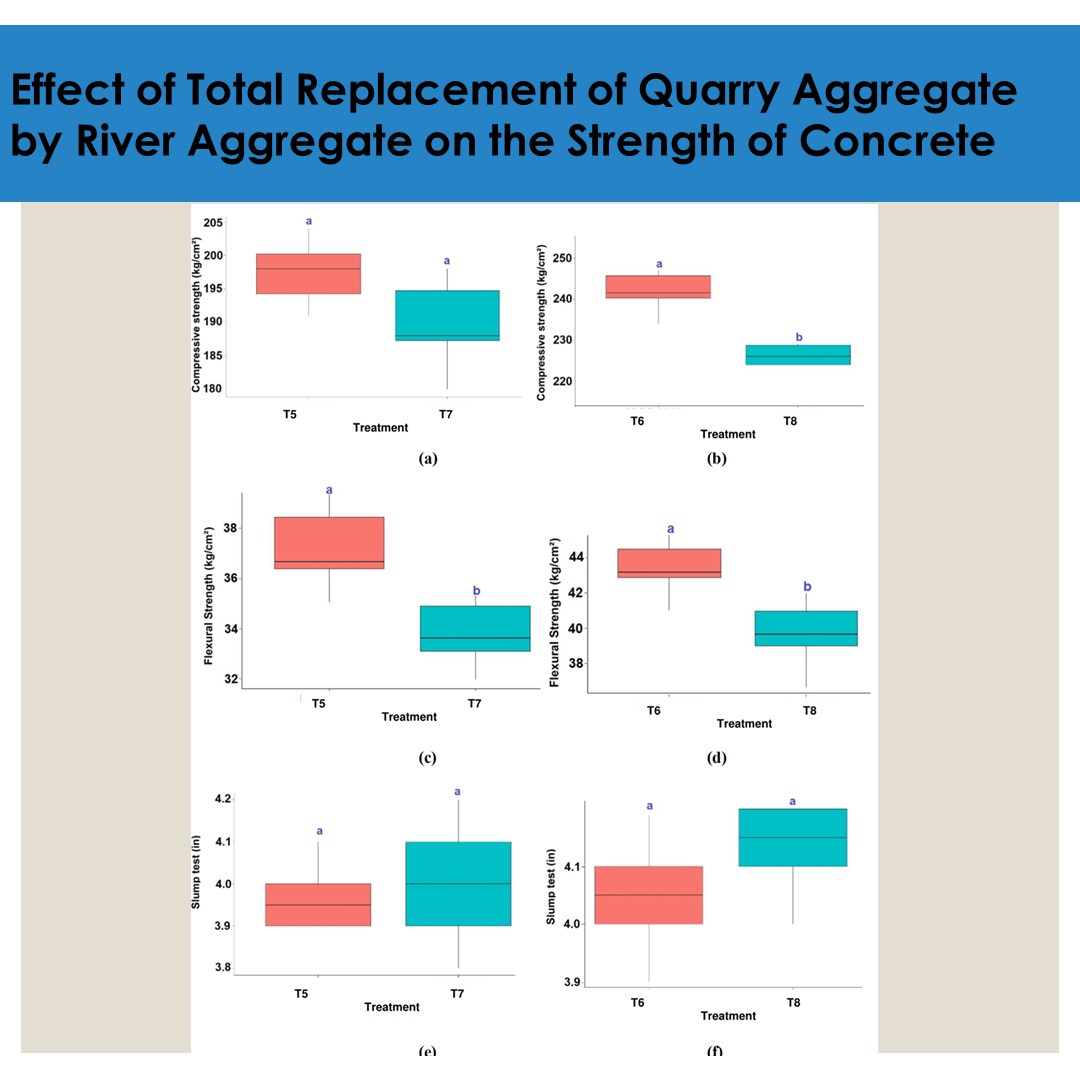Effect of Total Replacement of Quarry Aggregate by River Aggregate on the Strength of Concrete
##plugins.themes.bootstrap3.article.main##
Abstract
Currently, the collection and crushing process of fine and coarse aggregate has become costly and transportation time has increased due to the complexity of certain areas in the Peruvian highlands. As a consequence, river aggregate is extracted as a total substitution of fine and coarse aggregate for the preparation of structural concrete, but it is not known for sure if it is totally viable to use this aggregate for the benefit of construction interests. Therefore, the objective of this study is to evaluate the total substitution of fine and coarse aggregate by river aggregate obtained from the city of Cajamarca, Peru, on the mechanical properties of concrete. Concrete specimens were manufactured with fine and coarse aggregate and others with river aggregate from the Huaquillo and Portachuelo quarries, respectively. It is considered the designs of 175 kg/cm2 and 210 kg/cm2, in addition to tests such as slump, unit weight, compressive strength, flexural strength and an analysis of variance (ANOVA) in Tukey's block. An experimental campaign was carried out with cementitious pastes to evaluate the effect on physical and mechanical properties due to the use of river aggregate; the samples containing fine aggregate and coarse aggregate revealed good results in terms of mechanical properties. However, concrete made with river aggregate meets the minimum required theoretical design strength and is suitable to be used as a total substitute, which is a new and important scientific issue to highlight.
##plugins.themes.revistapolitecnica.stadistisDownloadTitle##
Downloads
Article Details
References
Aïssoun, B. M., Soo-Duck, H., & Kamal, K. H. (2015). Influence of aggregate characteristics on workability of superworkable concrete. Materials and Structures, 49(1-2), 597 - 609. https://doi.org/10.1617/s11527-015-0522-9
Ararsa, W., Tucay Quezon, E., & Aboneh, A. (2018). Suitability of Ambo Sandstone Fine Aggregate as an Alternative River Sand Replacement in Normal Concrete Production. American Journal of Civil Engineering and Architecture, 6(4), 140-146. https://doi.org/10.12691/ajcea-6-4-2
Beddaa, H., Fraj, A. B., & Ducléroir, S. (2021). Experimental study on river sediment incorporation in concrete as a full aggregate replacement: Technical feasibility and economic viability. Construction and Building Materials, 313, 125425. https://doi.org/10.1016/j.conbuildmat.2021.125425
Beddaa, H., Ouazi, I., Ben Fraj, A., Lavergne, F., & Torrenti, J.-M. (2020). Reuse potential of dredged river sediments in concrete: Effect of sediment variability. Journal of Cleaner Production, 265, 121665. https://doi.org/10.1016/j.jclepro.2020.121665
Da Silva, M., Pepe, D. S., Mende de Andrade, R., Shubert Pfeil, M., & Toledo Filho, R. (2017). Rheological and mechanical behavior of High Strength Steel Fiber-River Gravel Self Compacting Concrete. Construction and Building Materials, 150, 606-618. https://doi.org/10.1016/j.conbuildmat.2017.06.030
Duc-Trong, N., Duy-Liem, N., & MyNgoc-Tra, L. (2022). An experimental investigation on the utilization of crushed sand in improving workability and mechanical resistance of concrete. Construction and Building Materials, 326, 126766. https://doi.org/10.1016/j.conbuildmat.2022.126766
Eziefula, U. G., Opara, H. E., & Eziefula, B. I. (2020). Strength of concrete produced with different sources of aggregates from selected parts of Abia and Imo States of Nigeria. Journal of Engineering, Design and Technology, 18(5), 1053 - 1061. https://doi.org/10.1108/JEDT-08-2019-0220
Fadzilla Sari, F., Limantara, A. D., Ridwan, A., Gardjito, E., Subiyanto, B., Sudarmanto, H., . . . . Wiwoho Mudjanarko, S. (2020). Laboratory Testing on The Standard Mixed Designed Paving with Bamboo Material as Smooth and Rough Aggregate. IOP Conference Series: Earth and Environmental Science. 498, pp. 1-8. Jawa Timur, Indonesia: IOP Publishing Ltd. https://doi.org/10.1088/1755-1315/498/1/012032
Flores Fernández, A. M., Villafranca Castillo, A. J., & Reconco Amaya, J. A. (2019). Concrete with recycled aggregate: a construction material option with sustainability criteria. Unitec, 8, 120-124. https://doi.org/10.5377/innovare.v8i2.9023
García, J., Arriola, G., Villena, L., Muñoz, S. (2023). Strength of Concrete Using Partial Addition of Residual Wood Ash with Respect to Cement. Revista Politecnica, 52(1). 45-54. https://doi.org/10.33333/rp.vol52n1.05
Grinys, A., Augonis, A., Daukšys, M., & Pupeiki, D. (2020). Mechanical properties and durability of rubberized and SBR latex modified rubberized concrete. Construction and Building Materials, 248, 118584. https://doi.org/10.1016/j.conbuildmat.2020.118584
Güçlüer, K. (2020). Investigation of the effects of aggregate textural properties on compressive. Journal of Building Engineering, 27, 9. https://doi.org/10.1016/j.jobe.2019.100949
Hachani, M. I., Kriker, A., & Seghiri, M. (2017). Experimental study and comparison between the use of natural and artificial coarse aggregate in concrete mixture. Energy Procedia, 119, 182-191. https://doi.org/10.1016/j.egypro.2017.07.067
Laserna, S., & Montero, J. (2016). Influence of natural aggregates typology on recycled concrete strength properties. Construction and Building Materials, 115, 78-86. https://doi.org/10.1016/j.conbuildmat.2016.04.037
Limantara, A. D., Widodo , A., Winarto , S., Krisnawati , L. D., & Mudjanarko , S. W. (2017). Optimizing the use of natural gravel Brantas river as normal concrete mixed with quality fc = 19.3 Mpa. 4th International Conference on Civil and Environmental Engineering for Sustainability, IConCEES 2017. Langkawi. https://doi.org/10.1088/1755-1315/140/1/012104
Oliveira, M. A., Scotto, M. G., Barbosa, S., Freire de Andrade, C., & Freitas, M. d. (2020). Morphological controls and statistical modelling of boulder transport by extreme storms. Marine Geology, 426, 16. https://doi.org/10.1016/j.margeo.2020.106216
Orozco, M., Avila, Y., Restrepo, S., & Parody, A. (2018). Influencing factors in concrete quality: a survey of relevant actors in the concrete industry. Revista Ingeniería de Construcción, 33, 161-172. https://doi.org/10.4067/S0718-50732018000200161
Qing-Xiang, M., Dandan, L., & Yang, L. (2020). Mesoscale computational modeling of concrete-like particle-reinforced composites with non-convex aggregates. Computers & Structures, 240, 106349. https://doi.org/10.1016/j.compstruc.2020.106349
Solís-Carcaño, R. G., & Alcocer-Fraga, M. A. (2019). Durability of concrete with high absorption aggregates. Engineering, Research and Technology, 20, 1-13. https://doi.org/10.22201/fi.25940732e.2019.20n4.039
Tugrul Tunc, E. (2018). Strength Properties of Hardened Concrete Produced with Natural Aggregates for Different Water/Cement Ratios. European Journal of Science and Technology, 14, 280 - 287. https://doi.org/10.31590/ejosat.486093
Yan, J., Zhong, S., Chen, S., Lv, Y., Yang, L., Peng, G., & Deng, A. (2022). Study on the Application of Sediment-Based Embankment Building and Ultra-High-Performance Concrete (UHPC) Preparation in the Resource Utilization of Yellow River Sediment. Materials, 15, 5668. https://doi.org/10.3390/ma15165668
Yaragal, S. C., Basavana, G., & Rajasekaran, C. (2019). Characterization and performance of processed lateritic fine aggregates in cement mortars and concretes. Construction and Building Materials, 200, 10-25. https://doi.org/10.1016/j.conbuildmat.2018.12.072
Zega, C. J., Taus, V. L., & Di Maio, A. A. (2006). Physico-mechanical behavior of recycled concretes made with pebbles. Technical Bulletin, 44, 17-26. Retrieved September 10, 2023, http://ve.scielo.org/scielo.php?script=sci_arttext&pid=S0376-723X2006000300003&lng=es&tlng=.




